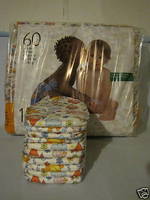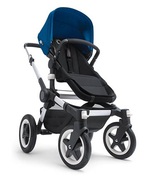Whoops, looks like I missed this story from the New Depression. Which I guess was the entire point of the company releasing the news on November 25, two days before Thanksgiving.
Kellwood, a women's apparel manufacturer which bought Gerber Childrenswear in 2002 and Hanna Andersson in 2007, spun the two companies off last fall in order to raise cash to pay off their revolving credit line.
The buyer was a new company called, imaginatively enough, Childrenswear LLC, and it is owned by Sun Capital Partners, the same LBO fund which took Kellwood private in Feb. 2008. The price: $179 million, or about 0.67x the two brands' combined 2007 revenue of $267 million.
What the press release says but doesn't say is that the only real value left in these two companies is the brands, i.e., whatever lingering awareness and misplaced goodwill is still stuck in parents' heads after all these years.
Check back for some possibly insufferable business school pontificating and number-crunching to follow.
[Thanks to DT reader DT for the tip; he spotted the liquidation auction that's following the closing of Gerber's last remaining packaging operation in Alabama, and started pulling the thread. Oh, and you're looking to outfit a distribution center, you might head down to Evergreen July 7-8. Lots of good deals.]
First things first, Gerber Childrenswear, or as we affectionately call them around here, "THE OWNER OF THE ONESIES REGISTERED TRADEMARK." Gerber Childrenswear was spun off to management from Gerber food and life insurance company in 1996 after Gerber was bought by the Swiss pharma giant Sandoz [which merged with Novartis; Gerber was later sold to Nestle.]
At the time, sales were around $200 million, split 70/30 between baby apparel and socks. GC went public in 1998, and stumbled along until it was bought in 2002 by Kellwood for $135 million (0.65x annual revenue, which was still around $200 million.)
In the conference call with analysts a Kellwood chairman literally said this was one of those ""two and two is five" transactions. Which is not what you want in the sock business, I guess, because they promptly sold the socks off in 2003 "to concentrate on its core business strategies." Socks still accounted for 30% or GC's revenue, or $59 of $200 million in 2002.
Now assuming Hanna Andersson had $100 million in revenue when Kellwood bought it in 2007, that leaves $167 million in revenue for Gerber [$267-100].
Which is absolutely fascinating to, uh, not even me, really. But it gives GC at least a five year lease on life. When the parent company spun off Gerber Childrenswear in 1996, they granted it a 10-year exclusive license to the company's trademarks, renewable for two five-year terms. [After that, the license goes year-to-year.] The first term expired in 2006, and for Gerber Childrenswear to get the second term, sales in the 10th year had to be $120 million or greater. And for GC to renew for a third term, 2011 revenue must meet or exceed 2006. For neatness, let's say it was $150 million.
Which DOES kind of fascinate me a little bit, because from the very beginning until now, that license and those trademarks form the entire basis for the company's existence. Or as they put it, GC "enjoys 100% brand awareness in the U.S. for the Gerber® brand."
And yet, except for a Gerber lawyer's single, inaccurate email to me five years ago, I haven't seen any evidence at all that GC is defending the Onesie trademark. The first use dates back to 1982, and it's explicitly mentioned in GC's licensing agreement, but generic use of the term "onesie" is rampant and ongoing in the baby industry. The NY Times's earliest mention of onesie was only in 1999, and the paper has never used it as anything but a generic type of clothing. It's almost as if Gerber Childrenswear didn't actually own the trademark and didn't really care that much if it survived for more than a few years.
As for Hanna Andersson, I have no idea. Apparently, it was a do-good, feel-good Baby Boomer baby catalog/store, but after the original owners sold out, all the warm fuzzy Scandinavian stuff got dumped, and ithe brand became just another mall fixture. Maybe it's just because the stores remind me of Crabtree & Evelyn, but the whole thing feels like a random chickfest with no compelling reason to keep existing. And well, with two changes of ownership and the New Depression® all hitting in one year, maybe it won't be around for much longer.



It's amazing the way the business world is constantly changing in the face of recession.
How can one company sell $59 million in baby socks? They almost certainly don't own the factories in which the socks are produced, and there is nothing clever or original about their product. They're socks. They are mostly cotton. They come in pink, white, yellow and blue.
OK, they've got a "trusted brand" and all that, but does anyone even notice (or care) what brand their baby socks are? Sometimes I really don't understand why things are the way they are.
They weren't baby socks, they were normal socks.
But you're exactly right; their actual product is nothing special at. all. In fact, it's kind of crappy. And it's completely outsourced. The only reason they sell anything at all is that smiley little Gerber Baby (R).
Hanna Anderson used to make pretty high-quality clothes -- stuff wouldn't fade or shrink or fall apart, and survived hand-me-downing through several iterations. Haven't purchased anything there in over a year (see: New Depression) but I recall it being more about huge throughput for your buck than about some sort of boomer do-good catalog pr0n.
I'd no idea it had been dumped/sold, though, and no idea if it sucks or is even viable now. But it would be a loss, because I can't think of anyone else who makes such long-lasting indestructible kids clothes these days.
Certainly not Gerber - those socks turn into dryer lint faster than you can say "registered trademark".
The Hanna case is actually pretty sad. Their clothes were reliable for quality and style, and survived the beating my daughter gave them. The drop-off in quality in the past year or two is noticeable, however. The fit isn't as reliable; the materials are cheaper; there is less of a push on the organic materials.
It's another example of what happens when a "brand" starts being about the name alone and not what made the name in the first place.
I'm shocked Andersson has even lasted this long -- it's dowdy and awful, and massively overpriced.
Dowdy? Hanna Andersson? What are you looking to dress your kid in, the stuff in Cookie mag that nobody would sensibly buy or ??? What's dowdy about bright colours and flowers and such? The lack of Disney characters or product slogans?
I love their clothes as they're comfortable, cheap when you shop the sales/outlet, and durable but, yeah, the change in the past year is noticeable and I fear they may not be around much longer. I hope they have a great sale before they die though.
Can you tell me if Nestle owns Hanna Andersson then? Thanks!